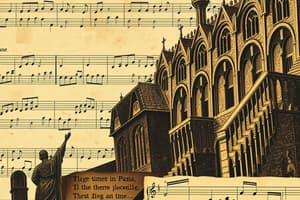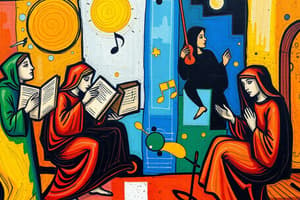Podcast
Questions and Answers
What are the two types of rondos mentioned?
What are the two types of rondos mentioned?
- ABAC
- ABACA (correct)
- ABCAB
- ABACABA (correct)
What is the structure of a classical concerto?
What is the structure of a classical concerto?
Three movements: fast, slow, fast.
What is a cadenza in a classical concerto?
What is a cadenza in a classical concerto?
A showpiece for the soloist.
What is classical chamber music designed for?
What is classical chamber music designed for?
Joseph Haydn was the composer for the ______ for 30 years.
Joseph Haydn was the composer for the ______ for 30 years.
What was Wolfgang Amadeus Mozart known for?
What was Wolfgang Amadeus Mozart known for?
What was significant about Beethoven's final pieces?
What was significant about Beethoven's final pieces?
What was the time frame for music in the Middle Ages?
What was the time frame for music in the Middle Ages?
In the Middle Ages, who did musicians primarily work for?
In the Middle Ages, who did musicians primarily work for?
What unique quality do Gregorian chants convey?
What unique quality do Gregorian chants convey?
How does the rhythm of Gregorian chant differ from other types of music?
How does the rhythm of Gregorian chant differ from other types of music?
What is a drone in music?
What is a drone in music?
What type of music were Troubadours and Trouveres known for?
What type of music were Troubadours and Trouveres known for?
What are the five sung prayers in the Mass?
What are the five sung prayers in the Mass?
Who was Pope Gregory I?
Who was Pope Gregory I?
What is the defining feature of Renaissance music concerning texture?
What is the defining feature of Renaissance music concerning texture?
What was the primary musical form during the Baroque period?
What was the primary musical form during the Baroque period?
What was the classical orchestra known for in terms of size and instrumentation?
What was the classical orchestra known for in terms of size and instrumentation?
What is a concerto grosso?
What is a concerto grosso?
What is the definition of a movement in music?
What is the definition of a movement in music?
Who was Claudio Monteverdi?
Who was Claudio Monteverdi?
What does 'word painting' refer to in music?
What does 'word painting' refer to in music?
What characterizes the texture of classical music?
What characterizes the texture of classical music?
Flashcards are hidden until you start studying
Study Notes
Middle Ages Music
- Time period spans from 450 to 1450.
- Musicians typically served in churches, courts, and towns; churches were central to musical life.
- Secular music and dance thrived; women participated in music only within convents.
Gregorian Chant
- Features a calm, otherworldly spiritual quality.
- Initially monophonic, eventually evolving to include organum (additional melodic lines).
- Melodies were derived from chant, characterized by stepwise motion and a narrow range.
Rhythm and Meter
- Gregorian chants exhibit a flexible rhythm without strict meter, creating a floating quality.
- The Notre Dame school pioneered the use of notation for indicating specific pitches and rhythms.
- In the Ars Nova style, rhythms became more complex, allowing subdivision and syncopation.
Tone Color and Melody
- Drones occasionally accompany vocal or instrumental music.
- Medieval music primarily utilized church modes rather than major/minor scales.
- Harmony considered intervals of a third dissonant, leading to a unique sound.
Renaissance Music
- Spanned 1450 to 1600, with a shift of musical patronage from the church to courts.
- Composers focused on appealing to a growing middle class, leading to increased public concerts.
- Secular music flourished with significant use of word painting to express emotions.
Texture and Form
- Renaissance music is predominantly polyphonic, often incorporating four to six voices.
- The texture varies from homophonic in lighter music to complex polyphony in choral works.
- The classical period emphasized homophonic texture, often featuring tuneful, easily remembered melodies.
Baroque Period
- Lasted from 1600 to 1750, characterized by a strong sense of rhythm and emotional expression.
- Introduced the basso continuo as a foundational element of harmony.
- Composers like Bach and Handel became prominent, with music often written for specific events.
The Classical Period
- Occurred between 1750 and 1820, with composers aiming to attract amateur musicians.
- Music became more accessible to the middle class, leading to a rise in home music-making.
- Classical forms included sonata-allegro, theme and variations, and rondo structures.
Notable Composers and Works
- Claudio Monteverdi, Purcell, and Bach were significant figures in early music.
- Mozart and Beethoven expanded the classical repertoire, composing across all genres.
- The operatic tradition, established by composers like Handel, became integral to the music landscape.
Performance Practice
- Renaissance choir typically featured male voices, with women excluded from liturgical services.
- Baroque music required performers to make choices regarding instrumentation and performance style.
- Classical performance shifted towards simpler accompaniments and composed cadenzas for soloists.
Studying That Suits You
Use AI to generate personalized quizzes and flashcards to suit your learning preferences.




